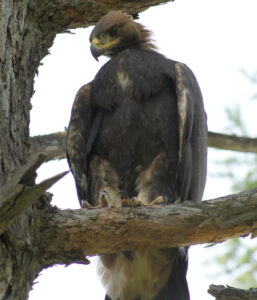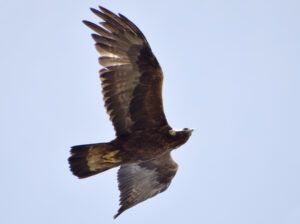Third International Scientific and Practical Conference “Eagles of the Palearctic: Study and Conservation”
Raptors Conservation. Suppl. 2. Proceedings of Conferences
The Cult of Eagle in the Mythology of the Khangalassians
Isaev A.P. (Institute for Biological Problems of Cryolitozone, SB RAS, Yakutsk, Russia)
Fedotov P.S. (Oktemskaya secondary school, Khangalassky District, Republic Sakha (Yakutia), Russia)
Nogovitsyn P.R. (Oyskaya secondary school, Khangalassky district, Republic Sakha (Yakutia), Russia)
Nogovitsyn V.P. (Lena Pillars National Park, Khangalassky District, Republic Sakha (Yakutia), Russia)
Gabyshev V.Y. (Institute for Biological Problems of Cryolitozone, SB RAS, Yakutsk, Russia)
Contact:
Arkady Isaev isaev_ark@rambler.ru
Peter Fedotov psfed52@rambler.ru
Prokopiy Nogovitsyn prokopi1955@gmail.com
Victor Nogovitsyn nvp11_52@mail.ru
Victor Gabyshev gabvich@mail.ru
Recommended citation: Isaev A.P., Fedotov P.S., Nogovitsyn P.R., Nogovitsyn V.P., Gabyshev V.Y. The Cult of Eagle in the Mythology of the Khangalassians. – Raptors Conservation. 2023. S2: 211–215. DOI: 10.19074/1814-8654-2023-2-211-215 URL: http://rrrcn.ru/en/archives/35031
The cult of eagle in the beliefs of the Yakutian (Sakha) people was described in detail in the beginning of the 20th century in the articles of V.M. Ionov (1913) and L.J. Shtenberg (1925). In recent years, the question of the semantics of the image of an eagle in the traditional culture of the Yakuts was addressed by U.P. Suzdalova (2020), the meanings of this bird of prey in mythological representations of the Sakha and Buryats by V.V. Ushnitsky (2021). Besides that, in a number of works related to the mythology of the Yakutian people, there is a mention of the eagle cult for Sakha (Kulakovsky, 1923; Alekseev, 1984; Gogolev, 2002, etc).
Each clan of the Sakha people considered some animal as their sacred patron. Among birds such animals were, first of all, birds of prey such as eagle, falcon, hawk, owl, and osprey. Of all totemic animals, the Yakut cult of the eagle was especially developed. Thus, in Yakut mythology this bird is often a link with the creator or a deity itself, belonging to the category of ayyl resident of the Upper World (Sternberg, 1925; Alekseev, 1969; Utkin, 1994; Gogolev, 2002; Ushnitsky, 2021). The Yakutian people consider Yuryung ayi toyon, a white lord of light, to be the head of the ayy. He does not interfere in people's affairs. "His verbs are thunder and lightning, his bird is an eagle dozing at his feet, and his emblem is the sun" (Seroshevsky, 1896). According to some concepts, this predator is considered a heavenly deity Homporuun Hotoi being an elder son of Uluuu toyon a great lord of the Upper World, or a formidable spirit of the Upper World, called Hunchbacked Hotoi Ayyy. In addition to all this, the canonization of the image of the eagle is connected with the notions: 1) this raptor is a solar symbol associated not only with the sun, but also with the cyclical change of seasons; 2) the eagle is the ancestor and patroness of Yakut shamans; 3) the bird that gave fire to people (Ionov, 1913; Kulakovsky, 1923; Utkin, 1994; Suzdalova, 2020).
An example of the Yakuts' special attitude to the eagle is shown in E.A. Novikov's feature film "Tsar Bird" filmed in 2018 based on a story by V.V. Yakovlev's story "A larch tree that grew old with me". This film won the Grand Prize at the 2019 Moscow International Film Festival. The film tells the story of an old man and an old woman who lived in the outback of Yakutia in the 1930s. At the beginning of winter, an eagle arrives in their yard and does not fly away. The old folks start feeding the hungry bird and, thinking it is a curse of the higher deities, invite a shaman. During the ritual it transpires that the old man has ruined the eagle's nest in the past, and the family takes the appearance of the bird as retribution from Hotoi Ayyy. Then, with the onset of severe cold, the bird flies into the old men's tent and settles in the corner. After a while, the owners get used to the neighborhood of the eagle and even begin to treat it as their own, believing that the bird has flown in to replace their dead son. At the end of winter, the eagle brings a fox as a thank-you before abandoning old men. In general, the film shows the Sakha people's adoration of the eagle, their attitude to it as a son of the formidable god Hotoi Ayyy, who can punish a man who has wronged him, and the belief that the soul of a dead man flies upwards and turns into an eagle.
The eagle is a sacred bird for people from Khangalassky District of Republic Sakha (Yakutia). According to legend, the bird helped the founder of their family, who was seriously wounded on the battlefield, to survive. When he was about to die, geese were flying over, and an eagle suddenly appeared from somewhere killed one of them with a blow of the leg and brought the dying man with the meat of the goose and thus a man survived. Subsequently, he became an ancestor of the Khangalas (Kulakovskii, 1923). Another explanation of the choice of the eagle as a totem bird is that the Khangalas considered themselves "Toyon uus", which literally translates as "Kin lord", and worship the deity "Toyon kyil" – "Lord of the animals", which they equate with an eagle (Nogovitsyn, 2008). Thus, the bird of prey is a patron of family, and a clan totem. It should be noted that except Khangalas the eagle is a totem of some clans of Khorin, which are spread almost all over Yakutia, and of the clans Botulu of the Verkhnevilyuisky and Chordu of the Olenek Ulus (Alekseev, 1969).
The image of the eagle was rooted in the world outlook of the inhabitants of Khangalassky district, revealing its manifestation at the present stage of history as well. Firstly, the heraldry in the district' coat of arms is indicative – a golden eagle with outstretched wings sitting on top of the tree of life Aal Luuk mas. In a major event held in the district’s administrative centre (Pokrovsk), the totem bird of Khangalasses decorated the emblem of Ysyakh Olonkho – 2014. In addition, many souvenirs, clothing items, etc., have the symbolism of this totem bird. It should also be noted that in 2014 a stele of a bronze eagle was erected in Kullaty, Khangalassky District, and in recent years, Yakutian people have developed a tradition of stopping at this monument and asking for the blessing of Khotoy Ayyy himself.
On the initiative of Khangalassky District administration and regional ethnographers, searches for golden eagle nests have been carried out during the last decade. Totally, 15 golden eagle nests have been found up to now on the District territory and 7 of them have been occupied. As a result of these works a project of ecological and biological justification to establish Maltaany Reserve has been prepared, the territory of which, in fact, is the breeding ground for the golden eagle’s whole Central Yakutian population.


